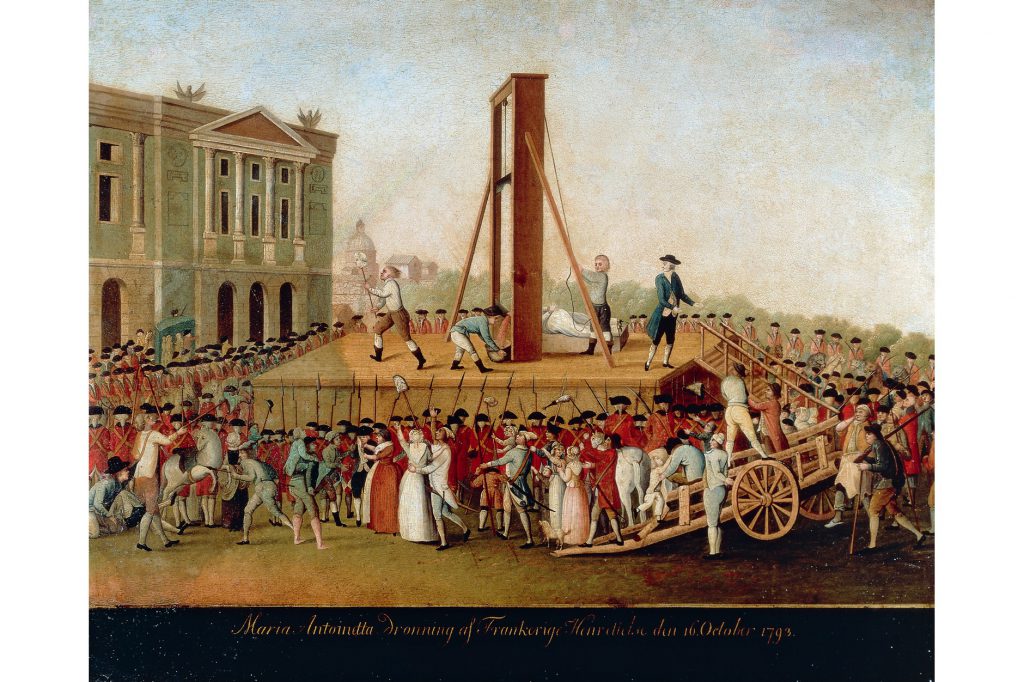
Two and a half months before her execution, at two in the morning, the Queen along with her daughter and sister-in-law were suddenly awakened and informed that the Queen was to be transported to the prison of Conciergerie. Without protest, Marie Antoinette got dressed and bid farewell to her family members. Then, without looking back, she left the temple. Fifteen minutes later, the Queen arrived in front of the grim towers of the Conciergerie, where she was registered under the name of “The Widow Capet” and became its 280th prisoner.5 She was led by the jailers to her new quarters. It was a dungeon of fifteen square meters with walls covered with an old cloth stained by humidity. It also had a narrow window at ground level that let in a pale light. Her only furniture consisted of a camp bed, two straw seat chairs, a convenience chair, and a bidet. Only a screen shielded her from the gaze of her guards and gave her no privacy at all. An assigned maid did everything she could to improve the Queen’s conditions during captivity.6

Alexander de Rougeville was loyal to the Republic at the beginning of the revolution; however, after he witnessed the Queen’s misfortune, he decided to help her to freedom. He had formerly been part of the Comte de Provence’s military establishment and was one of the officers who had protected her on June 20, 1792. That day, angry mobs broke into the Tuileries and forced the King to acknowledge the Republic. In addition, Marie Antoinette was insulted and called a traitor of France. In early September, he accompanied the royal family’s jail administrator Jean-Baptiste Michonis to the Conciergerie with two carnations pinned to his lapel. A plan called the Carnation Plot was attempted to aid the Queen to flee the country. Marie Antoinette picked up the flower and inside, the petal concealed a tiny note, which the Queen attempted to answer by pricking out a message with a pin. However, the gendarme on duty noticed her actions, took the incriminating evidence, and gave it to his immediate superiors. The name of the plot was taken from a flower that a certain Rougeville dropped at the Queen’s feet in her cell. The idea was for Marie Antoinette to escape to the château of Madame de Jarjayes. She was the Queen’s lady in waiting and her husband was General de Jarjayes, a loyal follower of the royal family. The Queen would then be transported to Germany, which was under the rule of Austria, Marie Antoinette’s homeland. The plot failed, but before the Republic could send the guards to capture him, Rougeville managed to escape.7
In the former Grand Hambre of the Palais de Justice, the Queen of France appeared before the Revolutionary Tribunal dressed in black and wore a widow’s bonnet in white lawn and trimmed with black mourning crepe. The Republic gave her lawyers less than a day to prepare a defense. One of the accusations against her was that she had been one of the instigators of the Champ-de-Mars massacre of July 1791, and that she had sent money out of the country to her brother, the Holy Roman Emperor. In addition, she was accused of scandalous conduct with her son, and that she had instigated most of the crimes that Louis XVI had committed. Marie Antoinette refused to respond to any charges. However, Marie Antoinette believed that she was innocent of these crimes and did everything within her power to save the monarchy as she conceived it. The entire trial started from October 15, 1793 at eight in the morning and ended on October 16 at four-thirty in the morning.8

On October 16, 1793, at four-thirty in the morning, Marie Antoinette was declared guilty of the three main charges of having secret agreements with foreign powers, of shipping money aboard to Austria, and of conspiring with these powers against the security of French. After ten weeks in the Conciergerie, the Queen’s incarceration came to an end. She was sentenced to death by guillotine and yet she remained impassive and simply shook her head at the verdict. As stated by Chauveau-Lagarde, Marie Antoinette showed true courage and was void of any negative emotion.9 Once returned to her cell, the Queen wrote a farewell letter to Madame Elisabeth, her sister-in-law. During the preparation for her execution, Rosalie witnessed the planned humiliation carried out on Marie Antoinette. First, she was obliged to prepare herself under the gendarmes’ watchful eyes. When she attempted to undress in a little niche between the wall and the bed, she signed to Rosalie to shield her. However, one of the men came around and stared at her. The humiliation continued when Charles Henri Sanson came and hacked off her thin white hair with enormous scissors. Marie Antoinette was also told her hands must be bound, even though the late Louis XVI hadn’t had his hands bounded. The next humiliation occurred when she was overcome with weakness and asked to have her hands unbound and squatted in the corner. Having relieved herself, she meekly held out her hands to have them bound again.10
The day was fine and slightly misty, as huge crowds lined the route to the Place du Carrousel’s guillotine and listened to the cries of the escort: “Make way for the Austrian woman!” and “Long live the Republic!”11 Mainly the crowd heard these cries with satisfaction. By the time the cart reached the Place du Carrousel, she was sufficiently in command of herself to step down easily. Stepping lightly “with bravado,” she sprung up the scaffold steps despite her bound hands, and paused only to apologize to her executioner for stepping on his foot.12 So she went willingly, even eagerly, to her death. The head of Marie Antoinette, desired by the leaders of the French Revolution, was cut off cleanly at 12:15 on Wednesday, October 16, 1793, and was exhibited to a joyous public.
On the very day of the execution, the Queen’s mutilated body was taken to the small cemetery of the Madeleine, where the King’s body had been left nine months earlier. On November 1, a gravedigger buried the Queen’s remains and sent the following note to the multiple authorities. “The widow Capet. 6 livres for the coffin. 15 livres, 35 sols for the grave and the gravedigger.” These words described the funeral of the last Queen of France.13 With the restoration of the monarchy, on January 18, 1815, the remains of the royal bodies were exhumed with the help of Pierre Louis Desclozeaux, an old lawyer who lived at 48 rue d’Anjou. He remembered the two interments and had subsequently tended the sites. He created a garden out of the area and planted two weeping willows as a commemoration. The bodies were then briefly held at the house in the rue d’Anjou. Prayers were said before they were sealed in new coffins with appropriate inscriptions of the majesty and titles of the occupants. On January 21, 1815, a formal procession led the coffins to the Saint Denis cathedral.14 Commemorative statues of Louis XVI and Marie Antoinette were built in the cathedral and their remains were reburied in the Bourbon vault.15
No longer considered one of history’s greatest criminals, the last Queen of France today arouses interest and compassion. After her death on the scaffold, Marie Antoinette entered the world of legend and became a mythical figure.16 Being a scapegoat for the revolution, the Republic’s political decision for her execution united France. Despite being a sacrifice for the French, she never lost her composure and retained her image as a dignified Queen until the last moment of her life.17
- Evelyne Lever, Marie Antoinette: The Last Queen of France (NY: Farrar, Straus and Giroux, 2000), 304-305. ↵
- Evelyne Lever, Marie Antoinette: The Last Queen of France (NY: Farrar, Straus and Giroux, 2000), 213. ↵
- Evelyne Lever, Marie Antoinette: The Last Queen of France (NY: Farrar, Straus and Giroux, 2000), 250-259. ↵
- Evelyne Lever, Marie Antoinette: The Last Queen of France (NY: Farrar, Straus and Giroux, 2000), 287-290. ↵
- Evelyne Lever, Marie Antoinette: The Last Queen of France (NY: Farrar, Straus and Giroux, 2000), 291-292. ↵
- Evelyne Lever, Marie Antoinette: The Last Queen of France (NY: Farrar, Straus and Giroux, 2000), 292. ↵
- Evelyne Lever, Marie Antoinette: The Last Queen of France (NY: Farrar, Straus and Giroux, 2000), 293-294. ↵
- Evelyne Lever, Marie Antoinette: The Last Queen of France (NY: Farrar, Straus and Giroux, 2000), 299-304. ↵
- Antonia Frazer, Marie Antoinette: The Journey (NY: Doubleday, 2001), 435-438. ↵
- Antonia Frazer, Marie Antoinette: The Journey (NY: Doubleday, 2001), 438-440. ↵
- Antonia Frazer, Marie Antoinette: The Journey (NY: Doubleday, 2001), 439. ↵
- Antonia Frazer, Marie Antoinette: The Journey (NY: Doubleday, 2001), 440. ↵
- Evelyne Lever, Marie Antoinette: The Last Queen of France (NY: Farrar, Straus and Giroux, 2000), 305. ↵
- Antonia Frazer, Marie Antoinette: The Journey (NY: Doubleday, 2001), 447. ↵
- Antonia Frazer, Marie Antoinette: The Journey (NY: Doubleday, 2001), 457. ↵
- Evelyne Lever, Marie Antoinette: The Last Queen of France (NY: Farrar, Straus and Giroux, 2000), 308-309. ↵
- Antonia Frazer, Marie Antoinette: The Journey (NY: Doubleday, 2001), 453. ↵




80 comments
Barbara Ortiz
What I loved most about your article was showing how composed she was following the death of her husband, the King, her imprisonment, and knowing that her death, in the same method as had taken her husband, would eventually come to pass. I does not seem like there was any hope that she could have come out of this predicament alive. The revolution was already too brutal and sadistic.
Anayetzin Chavez Ochoa
I’m probably the Nth person to mention the “Let them eat cake” quote everyone attributes to Marie Antoinette, which is a debated false claim if I remember correctly, but that’s another story. It’s good to know the story from the “hunted” during this part in time: most people know how brutal the revolution was and that it was a peasant-led revolution (i.e. 97% of the population). I could sense the humiliation radiating from her experience in prison, and there’s a good chance more happened beyond written accounts. “No one in history sees themselves as a villain” is a quote from many actors playing villains, and I can see it in the Queen as she tries to defend herself. But without the revolution, where would we be? Interesting that she maintained her composure, for the most part. Great article, I learned so much!
Hailey Koch
You did such a great job on your article, I really enjoyed reading it. I loved how you included such great images that follow the story and provide the reader with something to connect to the story. At the end of the article, I had learned that the Queen’s body was put to rest by the king. The king had been put to rest only 9 months before the kings. Even though the two had died close in time together it was amazing how they were able to rest close to each other and a garden was surrounding them.
Jaedon E
That was a very interesting story about what led up to Marie Antoinette execution. I did find it astonishing how she was very passive from how the public and everyone was treating her. No matter how much hate she received she fought back with kindness and positivity. When she heard the verdict to her case, most people would react in various way, she jus shook her head and accepted her punishment. I find that not so much just taking responsibility of her accusation actions but knowing what good does the world have to offer her in this time.
Overall great article!!
Kristen Leary
This was such a well written article! It is most definitely very descriptive, and written incredibly well. You did a good job of using imagery to set the scene and mood of the story. It is very easy to follow and engaging for the reader, and you did a good job at selecting and placing your images as well. Congratulations on a wonderful article!
Lauren Deleon
You did a wonderful job telling the story of Marie Antoinette! I was waiting for the “Let them eat Cake” moment, even though I know the saying is more of a legend. I would be very interested in knowing where that came from, I am sure that is a topic of someone else’s research somewhere out there. Anyways, the description you gave about the Queens life in prison was very enlightening, I cant imagine how she felt going from such a privileged life to a life of hardship. Well done!
Sofia Perez
I do not know much about Marie Antoinette other than her famous saying, ” Let them eat cake!” I did not know she was the last queen of France. Marie Antoinette was charged on three accounts of having covert agreements with other countries, sending money to Austria from abroad, and collaborating with these powers to undermine French national security. Through all the humiliation leading up to her execution, she stayed strong and kept her composure.
Priscilla Leal
Marie Antoinette has been popularized in pop culture and its refreshing getting to read about the end of her life through this article. Her story is very captivating and also shows that a monarchy can come to an end if the people believe it is the right thing. The majority of France was not loyal to the crown. Very well put together article.
morris kelley
I though Marie was executed at the Place de la Revolution, not the Place de la Carrousel. Which was it?
Nicholas Quintero
this article had really great structure that made it flow and easy to follow along. the use of imagery, especially in the first paragraph where it discusses the outcome of the article is perfect, as it hooks the reader and makes them interested to read the rest of the article.